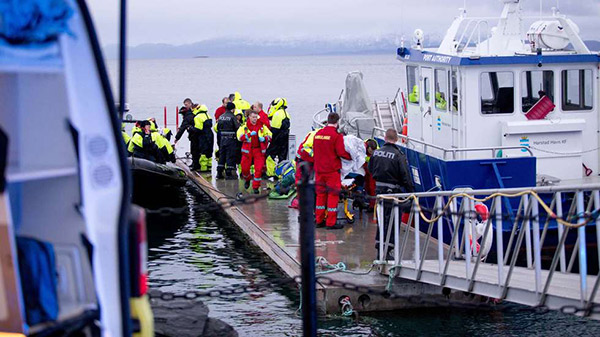What happened?
The Norwegian Maritime Authority (NMA) recently received the report from the AIBN on the accident involving the RIB Hugin. On 16 February 2017, a charter RIB collided with the fountain Selsbanes Seil in Harstad harbour. Eleven persons ended up in the water. Everyone was rescued, but two persons sustained serious injuries. There has been a previous report from the AIBN concerning two persons falling overboard from a RIB. This happened in Olden on 22 July 2015, and the driver was killed in the accident. Both reports included recommendations that the NMA is currently working on.
This autumn, the NMA has recorded three other RIB incidents resulting in serious injuries.
The first incident occurred as a RIB hit a wave/breaker. The vessel was subject to severe impact, causing the front row of seats to break free from the deck. The passengers seated on this part of the deck fell overboard, but were picked up from the water shortly after. One of the passengers most likely suffered a concussion. The other passengers were unharmed.
In the other two incidents, there were passengers that broke their backs. The injuries were probably caused by the shock impacts suffered when sitting on the seats as the RIB was hitting the waves at high speed. One of the passengers involved in one of the incidents had a previous back injury.
Causes
RIBs are light craft with powerful engines operating at a high speed. The driver and passengers must be extremely alert due to both the speed and the forces imposed on the RIB. The vessels are often used to create extraordinary experiences with close encounters with the sea and forces of nature, and it is quite common to get hit by sea spray in the face. If the driver is unaware of the forces imposed on the vessel, the trip may result in fatal stress and injuries to the persons on board. It is vital to make sure that all necessary safety margins are considered for such circumstances and speed, and the driver must be competent and experienced.
From the reports we have received, we see that the combination of light craft, speed and waves could be one cause for the incidents. The passengers are required to pay attention to the vessel’s movements and act on them. However, the apprehension of speed and sudden movements can make this hard. Sometimes it is difficult to know what the passengers will experience and what consequences to expect. The driver and the crew members on a RIB have an important job. This includes taking into consideration that the passengers have different backgrounds, physiques and perceptions of reality when it comes to what happens during a trip.
Lessons learned
It is important that the tour operator and driver give the passengers a safety briefing before departure, cf. section 5 in Regulations on the operation of vessels carrying 12 passengers or less, etc.
The crew and passengers must be aware that this may, and in most cases will, be a trip with possible strong impact on the body. Based on the provided information, the passengers should make their own assessment of whether they should join or not. All passengers must consider their own health situation including illnesses and injuries that may be affected due to sudden movements and impacts. The operator and driver must make sure that the passengers are wearing floatation suits or life vests to ensure a safe voyage. Moreover, the provided information must be understood by everyone on board. It is also important to provide information regarding safety and routines for conduct and communication on board.
The RIB driver is responsible for ensuring a safe voyage. However, passengers also need to be aware of the impact they may be exposed to on board a RIB. A trip on a RIB can be pleasant and calm, but jumping the waves during high-speed sea rafting, truly experiencing the forces of nature, is quite another thing.
Links:
Regulations on the operation of vessels carrying 12 passengers or less, etc.
Section 5. Safety briefing
|
(1) The company shall ensure that passengers are given a safety briefing immediately before departure. The briefing shall be adapted to the purpose of the trip, and shall as a minimum include the following: |
|
|
a) |
use of life-saving appliances; |
|
b) |
use of safety equipment; |
|
c) |
the essential actions passengers must take in an emergency; |
|
d) |
special situations that can be expected during the trip. |
|
(2) Pregnant women, as well as persons with back, neck or pelvic injuries or similar health problems shall be informed about the risk associated with vessels operating at speeds of 20 knots or more. |
|
Report on marine accident – RIB, fall overboard in Olden 22 July 2015
Report on marine accident – Hugin, collision in Harstad on 16 February 2017

